Satellite Imagery Analysis 2024/09/25
Ukrainian Cross-border Incursion and Safeguarding of Nuclear Power Plant Safety
Yuki Kobayashi (Research Fellow, Sasakawa Peace Foundation)
1. Ukrainian cross-border incursion into Russia
On August 24, it has been two years and a half since Russia started to militarily invade into Ukraine. In early August, with the war in deadlock, Ukrainian forces launched an attack across the border into the Russian territory, bringing the war into a new phase. President of Ukraine Volodymyr Zelenskyy said that Ukrainian forces had taken control of more than 90 settlements in Kursk region, Russia, over 1,250 square kilometers, an area equivalent to more than half the area of Tokyo.[1] Ukraine captured Sudzha, a transit point for natural gas into Europe and one of Russia’s strategically important locations (see Figure 1), and destroyed all the key bridges over the Seym River in the region to prevent Russia from supplying its troops.[2]
Figure 1: Map of Kursk region
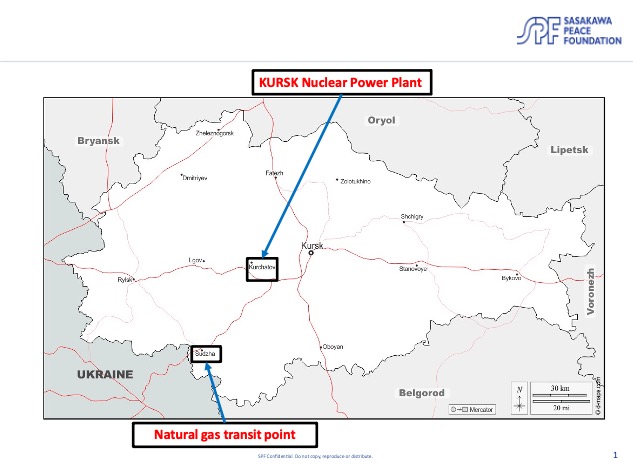
This is the first time in 85 years since the outbreak of World War II that any part of the Russian territory has been occupied by foreign national forces. This is also the first time a non-nuclear weapon state has occupied any part of a nuclear-weapon state’s territory, giving rise to considerable controversy over the effectiveness of nuclear deterrence.[3]
One point to note regarding the Ukrainian cross-border incursion is the need to secure the safety of a nuclear power plant (NPP) as has been the case with the ongoing Russian occupation of the Zaporizhzhia NPP in southeastern Ukraine. As shown in Figure 1, only several tens of kilometers from the current battle front line of the Ukrainian forces sits the Kursk NPP, which is in operation. Given the size of the Ukrainian troops deployed for this cross-border mission, the likelihood of the situation developing into the immediate seizure of the NPP is not so high. However, no optimism is warranted. In the event of damage to the nuclear facilities amid escalating fighting between the two sides, it could cause radioactive releases and significant impacts on the surrounding environment. In addition, the reactors in operation at the Kursk NPP are structurally more vulnerable to external shocks than those at the Zaporizhzhia NPP, prompting Rafael Mariano Grossi, Director General of the International Atomic Energy Agency (IAEA) to issue a statement calling on both sides to refrain from fighting near NPPs.[4]On August 26, Director General Grossi himself visited the Kursk NPP, leading a team of IAEA inspectors.[5]
The Sasakawa Peace Foundation (SPF) examined newly acquired satellite imagery and IAEA data to assess the current state of the Kursk NPP.
2. Overview of the Kursk NPP
According to official IAEA data, the Kursk NPP (see Figure 1), located in Kurchatov in the western Kursk region, has a total of six reactors. An overview of each reactor is as shown in Table 1 below.
Table 1: Overview of the Kursk NPP
| Reactor | Type | Power (Megawatt) |
First Grid Connection |
Status |
|---|---|---|---|---|
| KURSK-1 | ||||
| Unit 1 | RBMK | 1,000 | 1976/12/19 | Shut down |
| Unit 2 | RBMK | 1,000 | 1979/01/28 | Shut down |
| Unit 3 | RBMK | 1,000 | 1983/10/17 | Operational |
| Unit 4 | RBMK | 1,000 | 1985/12/02 | Operational |
| KURSK-2 | ||||
| Unit 1 | PWR | 1,255 | Under Construction |
|
| Unit 2 | PWR | 1,255 | Under Construction |
Source: Created by the author based on the IAEA’s “PRIS Country details-Russian Federation.”
Nuclear reactors are called by varied names depending on the medium used to reduce the speed of release of neutrons (neutron moderator) for efficient nuclear fuel fission reactions. Graphite-moderated reactors are a type of nuclear reactors that use graphite (material for pencil cores) as a neutron moderator. Using heat from nuclear fuel, water is boiled to produce steam, which is fed into turbines to generate electricity. Developed by the former Soviet Union, Units 3 and 4 shown in the above table are officially called graphite-moderated, boiling light water-cooled, pressure tube type reactors, also known as RBMK, a Russian abbreviation for high power channel reactors. RBMKs, which are the first and oldest type of nuclear power reactors in the world, are also known as the type of the reactor that caused a devastating accident in April 1986 at the Chernobyl NPP in Ukraine (then part of the Soviet Union).
In contrast, the light water reactors (or pressurized water reactors: PWRs) under construction at Kursk-2 are a type of reactors that are filled with normal water (referred to as “light water” to differentiate from heavy water with higher density) as a moderator and generate electricity by turning turbines with a massive amount of steam produced by heat from nuclear fuel. Currently, more than 80% of nuclear reactors in the world are light water reactors. All the operating reactors in Japan are light water reactors and so are those of the Fukushima Daiichi Nuclear Power Station that melted down in the aftermath of the great earthquake and tsunami on March 11, 2011.
Satellite Image 1: Kursk NPP (August 18, 2024)
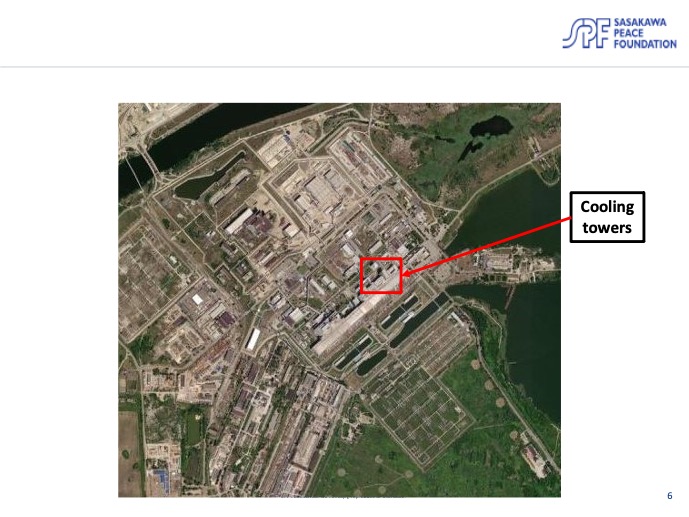
Source: Maxar. Courtesy of Hajime Matsukubo, Secretary General, Citizens’ Nuclear Information Center
In Satellite Image 1, we can see two cooling towers (framed in the red box), typically observed in nuclear power plants with graphite-moderated reactors. A cooling tower is a facility used to extract waste heat from the reactor and release it into the atmosphere.
3. Vulnerabilities of graphite-moderated reactors
As discussed earlier, both graphite-moderated reactors and light water reactors have had major accidents. It has been pointed out, however, that graphite-moderated reactors are more laden with safety vulnerabilities, including weakness to external shocks, than light water reactors. Currently, Russia is the only country where RBMKs are still in operation.[6]
In the case of light water reactors, each reactor is covered with a steel containment vessel, which is enclosed in a reinforced concrete building. Even in the event of a reactor abnormality, such as a nuclear fuel meltdown leading to radioactive leakage from the reactor, the containment vessel contains the leakage. On the contrary, graphite-moderated reactors usually do not have such containment vessels and thus their function to contain radioactive materials in the event of a reactor abnormality is weaker.
In the Chernobyl nuclear power plant accident, one graphite-moderated reactor melted down. In contrast, the Fukushima Daiichi nuclear power plant accident involved the meltdown of three light water reactors, and a massive amount of hydrogen gas by melting nuclear fuel formed in two of them leaked out, caught fire, and exploded, blowing off the roofs and outer walls of the buildings enclosing the reactors and containment vessels. In addition, another hydrogen explosion occurred in a separate building where spent fuels are stored in a pool of water. As such, the Fukushima Daiichi accident was seemingly more serious than the one at Chernobyl. However, a comparison of figures shows otherwise, i.e., the area contaminated and the maximum distance reached by cesium-137, a radioactive material, emitted in the Fukushima Daiichi accident are respectively some 6% and one tenth of those in the Chernobyl accident.[7] From this, we can see that, despite the hydrogen explosions, the containment vessels at Fukushima Daiichi remained sound, fulfilling their function of containing radioactive materials, at least to an extent. In contrast, the accident at the Chernobyl NPP, which had no containment vessels and was weak in its containment function, resulted in the spread of radioactive contaminants across extensive areas of Europe.
Regarding those weaknesses of graphite-moderated reactors, IAEA Director General Grossi has been voicing concern. “The fact that the plant is operating makes it even more serious,” Grossi said, during his visit to the Kursk NPP on August 26. Describing the site as “exposed and fragile,” he said, “A nuclear power plant of this type so close to the military front is an extremely serious fact.”[8] It seems that Russia, too, has recognized the vulnerabilities, as satellite images of an area near the Kursk NPP show that significant changes have occurred over a period of one month. Look at the three images shown below.
Satellite Image 2: Spot under observation (bottom right) near the Kursk NPP
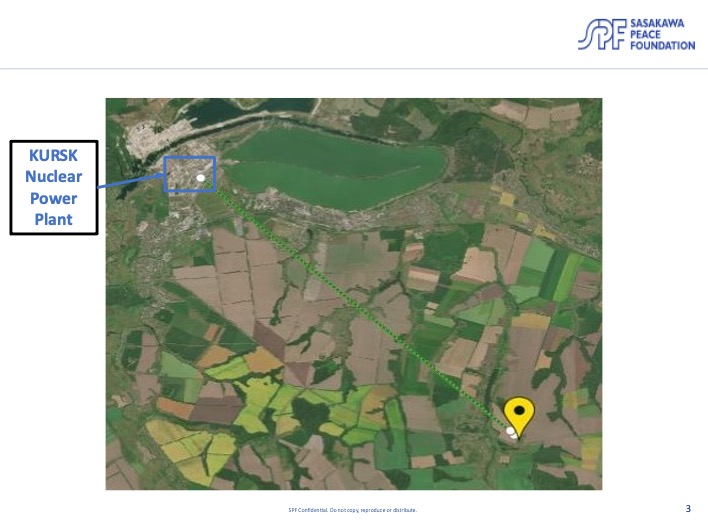
Source: Sentinel2. Courtesy of Hajima Matsukubo, Secretary General, Citizens’ Nuclear Information Center.
The scenery of the fields shown in Satellite Image 2, located about 15 km from the Kursk NPP in the direction of an area where Ukrainian forces are being deployed, has changed significantly.
Satellite Image 3: Spot under observation near the Kursk NPP (July 9, 2024)
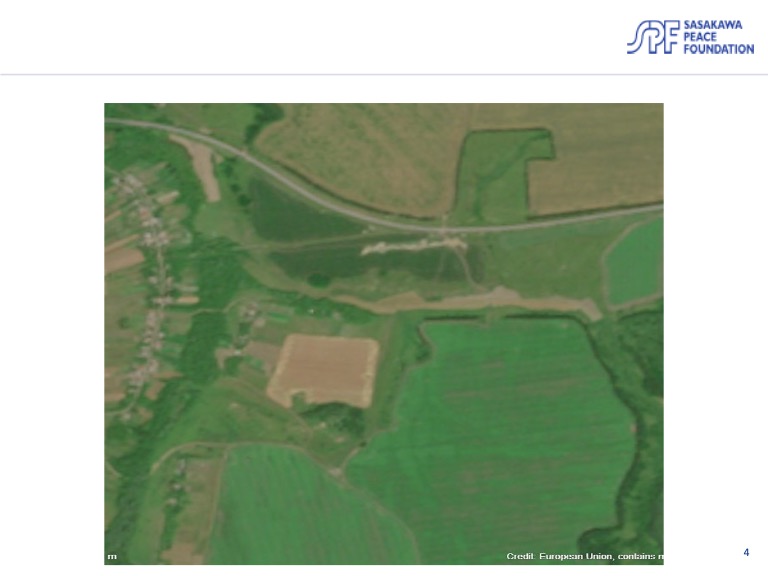
Source: Sentinel2. Courtesy of Hajime Matsukubo, Secretary General, Citizens’ Nuclear Information Center.
As shown in Satellite Image 3, the scenery of the spot was that of an ordinary rural area as of July 9, 2024.
Satellite Image 4: Spot under observation near the Kursk NPP (August 18, 2024)
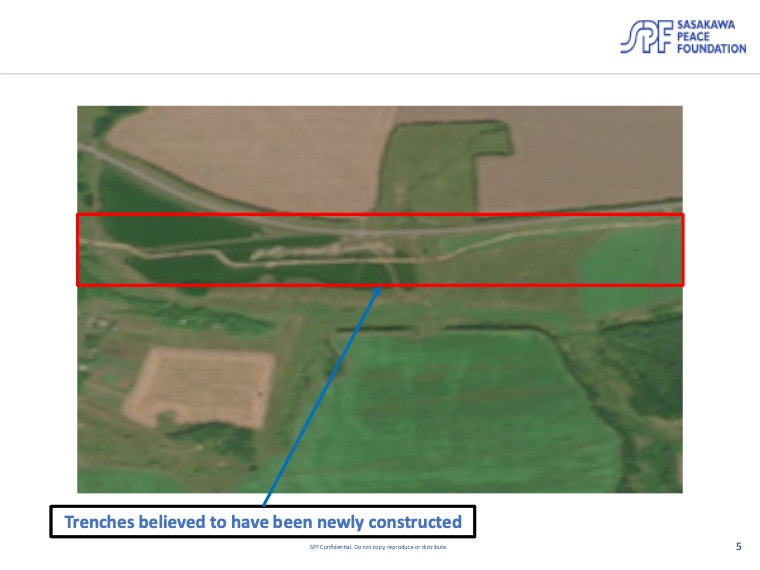
Source: Sentinel2. Courtesy of Hajime Matsukubo, Secretary General, Citizens’ Nuclear Information Center.
An image of the same spot captured on August 18, 2024, shows long stretches of ditches (see the portion inside the red frame in Satellite Image 4). It has been reported that Russia is building trenches in various parts of the Kursk region in preparation for advances by Ukrainian forces,[9] and those shown in the image are believed to have been built as part of that effort.
4. Securing the safety of nuclear facilities in times of war
The fact that the IAEA director general issued a statement on and made a visit to the Kursk NPP, following and in addition to the Zaporizhzhia NPP, highlights a characteristic of the ongoing war. That is, the eventuality of the ongoing hostilities causing damage to nuclear facilities, thereby triggering a massive release of radioactive materials, has now become a real possibility. Additional Protocol (I) of 1977 to the Geneva Convention, in principle, prohibits military attack on nuclear power facilities.[10]The intention is to prohibit attack on facilities containing dangerous forces, such as nuclear power plants, because destruction of such facilities would cause severe losses among the civilian population.
As one of the countries using nuclear energy for civilian purposes, and as the country that have experienced the Fukushima Daiichi accident and thereby learned first-hand knowledge of how an accident at a nuclear facility could affect human health and the environment, Japan should raise an international debate on securing the safety of nuclear facilities in times of war.
(ENDS)
1 “Rosia Hofuku no Odoshi wa ‘Hattari,’ Ekkyo Kogeki Meguri Zerenski-shi [Kyiv: our Kursk attack shows Kremlin red lines are bluff],” Reuters, August 20, 2024.[https://jp.reuters.com/world/ukraine/OONZG7NI4NL7HAGPEDOYNFGZXE-2024-08-20/]
2 “Ukuraina, Kurusuku-shu de 3-bonme no Hashi Hakai: Rosia Chosai ga Kakunin [Moscow says Ukraine struck a third bridge over Seym river in Russia’s Kursk region],” Reuters, August 19, 2024.[https://jp.reuters.com/world/ukraine/DS37XZTUTNIRDNHKQHUFSS3PPY-2024-08-19/]
3 For instance, see “Rosia no ‘Kaku no Odoshi’ Kikazu, Ukuraina, Kunren Giso shi Ekkyo: Hoyukoku ni Hatsu no Daikibo Shinko, Kaku Yokushi Meguru Giron ni Isseki [Russia’s ‘Nuclear Threat’ does not Work and Ukrainian Troops Crossed the Border under the Disguise of an Exercise: The first ever large-scale invasion into a nuclear-weapon state causing a stir in the debate over nuclear deterrence],” Nikkei, August 17, 2024 (Subscribers only).
4 “IAEA Director General Statement on Developments in the Russian Federation,” August 9, 2024.[https://www.iaea.org/newscenter/statements/iaea-director-general-statement-on-developments-in-the-russian-federation]
5 IAEA Director General Statement on Kursk Nuclear Power Plant,” August 26, 2024.[https://www.iaea.org/newscenter/pressreleases/iaea-director-general-statement-on-kursk-nuclear-power-plant]
6 ATOMICA, “Cherunobuiri Genshiryoku Hatsudensho Jiko no Gaiyo [Overview of Chernobyl Nuclear Power Plant Accident],” January 2007.[https://atomica.jaea.go.jp/data/detail/dat_detail_02-07-04-11.html]
7 Ministry of the Environment of Japan, “Cherunobuiri Genshiryoku Hatsudensho Jiko to Tokyo Denryoku Fukushima Daiichi Genshiryoku Hatudensho Jiko no Kibo no Hikaku [Comparison in Size between the Chernobyl Nuclear Power Plant Accident and the Tokyo Electric Power Company Fukushima Daiichi Nuclear Power Station Accident].”[https://www.env.go.jp/chemi/rhm/h30kisoshiryo/h30kiso-02-02-06.html#:~:text=%E6%9D%B1%E4%BA%AC%E9%9B%BB%E5%8A%9B%E7%A6%8F%E5%B3%B6%E7%AC%AC%E4%B8%80%E5%8E%9F%E5%AD%90%E5%8A%9B%E7%99%BA%E9%9B%BB%E6%89%80%E4%BA%8B%E6%95%85%E3%81%AF,%E8%A6%8F%E6%A8%A1%E3%81%A8%E3%81%AA%E3%81%A3%E3%81%A6%E3%81%84%E3%81%BE%E3%81%99%E3%80%82]
8 Bloomberg, “Rosia no Kurusuku Genpatsu, Kado Keizoku de Risuku Takamaru – IAEA ga Keikoku [Nuclear Watchdog Says Russia Elevates Risk Running Kursk Reactor],” August 28, 2024.[https://www.bloomberg.co.jp/news/articles/2024-08-28/SIVSY0DWX2PS00]
9 BBC, “Ukuraina ga Ekkyo Kogeki de Zenshin, Rosia wa Zango o Secchi: Eisei Gazo de Wakaru Koto [Russia is building trenches as Ukrainian Forces Continue Advances in the Cross-border Incursion: What We can Tell from Satellite Images and Videos],” August 15, 2024.[https://www.bbc.com/japanese/articles/c39kv2vz72zo]
10 Article 56 (1) of Additional Protocol (I) to the Geneva Conventions, 1977, provides as follows: “Works or installations containing dangerous forces, namely dams, dykes and nuclear electrical generating stations, shall not be made the object of attack, even where these objects are military objectives, if such attack may cause the release of dangerous forces and consequent severe losses among the civilian population. Other military objectives located at or in the vicinity of these works or installations shall not be made the object of attack if such attack may cause the release of dangerous forces from the works or installations and consequent severe losses among the civilian population.”





